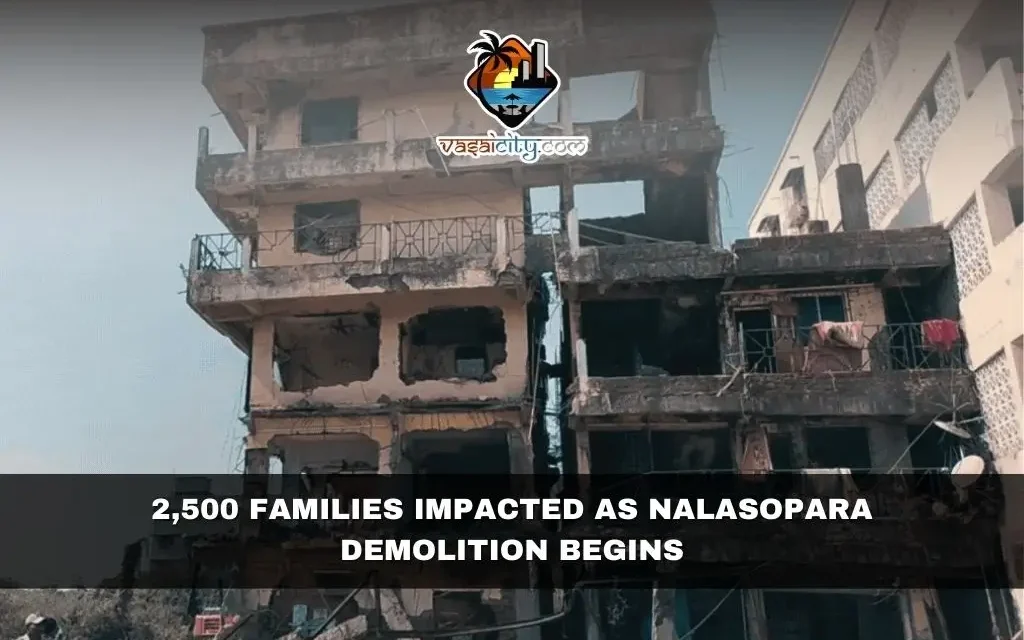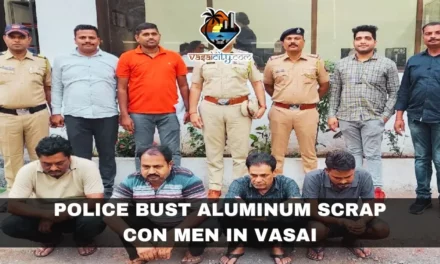Over 2,500 families in Nalasopara East are grappling with uncertainty and loss as the Vasai Virar Municipal Corporation (VVMC) begins demolishing 41 unauthorized buildings in Agrawal Nagari. The large-scale action, which started on Thursday, follows a protracted legal battle that left the residents with no reprieve from either the Bombay High Court or the Supreme Court. The area in question spans a massive 60 acres, of which 30 acres were allegedly encroached upon by former Bahujan Vikas Aghadi corporator Sitaram Gupta. Gupta, implicated in several land-related offenses, was arrested by the Economic Offences Wing in September last year.
Eviction Notices and Police Presence
On Wednesday, residents received fresh eviction notices, urging them to cooperate with the demolition process. The VVMC’s actions have been undertaken with heavy police security to prevent resistance or unrest during the operation. According to officials, the demolition is expected to take nine days, with the current focus on dismantling parts of the flats rather than completely bringing down the structures in one go. On the first day, eight buildings were scheduled for partial demolition.
This action is not entirely unexpected for the residents. The VVMC initially issued a 24-hour eviction notice on July 2, giving occupants a narrow window to vacate. However, an appeal to the Bombay High Court resulted in a temporary stay, extending the deadline to October 30. Despite the extension, the court upheld the demolition order, citing the unauthorized nature of the buildings. Subsequently, the Supreme Court also dismissed a Special Leave Petition filed by the affected families, effectively granting VVMC the green light to proceed.
Legal and Land Ownership Disputes
The Supreme Court emphasized that the buildings were constructed illegally on land earmarked for public infrastructure projects. The plot had been designated as a site for a dumping ground and sewage treatment plant as part of a 2010 development plan. The petitioners, three elderly brothers living abroad — Mohanlal Patel, Ramanlal, and Dhirajlal — claim ownership of the wetlands since 1977. They had given power of attorney to their younger brother, Ramdas Patel, a Vasai resident, who in turn transferred the rights to his son Piyush Patel and Ajay Sharma. According to the petitioners, their land was re-designated for public use without notice or compensation, a move they continue to challenge.
This is not the first time illegal constructions have been targeted in this area. A writ petition filed by Harit Vasai Saurakshan Smriti led to the demolition of 200 structures in 2013-14. Yet, unauthorized chawls and buildings continued to emerge, driven by increasing demand for affordable housing among the working-class population.
The Human Cost of Demolition
The affected families, many of whom have lived in the area for over 15 years, now face an uncertain future. These working-class residents claim to have purchased their homes through periodic cash payments made to local agents and builders. Unfortunately, most lack the legal documentation required to prove ownership, leaving them without a safety net as their homes are razed.
The residents are now appealing to the government for alternative housing. While the VVMC has asked individuals with proof of purchase to approach the municipal office for necessary certificates, many occupants lack sufficient paperwork. The Supreme Court, in its ruling, noted that those affected could seek rehabilitation from the government but did not outline specific provisions for their resettlement.
“We were assured that the homes we bought were legal,” said one resident, who did not wish to be named. “We have been paying property taxes and other dues for years. Now, we are being told that our homes are illegal. Where will we go?”
Encroachment and Alleged Misuse of Power
The issue of encroachment on wetlands and private property has long plagued the area. Former corporator Sitaram Gupta is accused of facilitating the sale and construction of illegal buildings on encroached land. His arrest in September 2023 by the Economic Offences Wing further highlighted the extent of corruption and misuse of power involved in these unauthorized developments.
According to the petitioners, these encroachments began after the development plan was introduced in 2010. Despite multiple demolitions and legal actions, illegal constructions continued to mushroom, often with the tacit approval or indifference of local authorities.
The Long Road Ahead for the Displaced
The displacement of over 2,500 families underscores the housing crisis in rapidly urbanizing areas like Nalasopara. For many of the affected residents, the demolished buildings were their only refuge in an otherwise unaffordable real estate market. These individuals now face the daunting task of rebuilding their lives, potentially starting from scratch.
The VVMC’s decision to allow those with purchase proofs to apply for necessary certificates offers a sliver of hope to a small segment of residents. However, the lack of clarity on rehabilitation measures remains a significant concern. Many are calling for a more comprehensive approach that includes temporary housing and financial assistance for those rendered homeless.
Conclusion
As the demolition continues, the story of Agrawal Nagari serves as a stark reminder of the consequences of unchecked urbanization, illegal construction, and systemic corruption. While the legal system has upheld the VVMC’s actions, the human cost of this large-scale eviction cannot be ignored. For the displaced families, the next steps remain uncertain, and the burden of finding a solution now lies with the government and civic authorities. Whether their appeals for rehabilitation will be addressed in a timely and compassionate manner remains to be seen.









